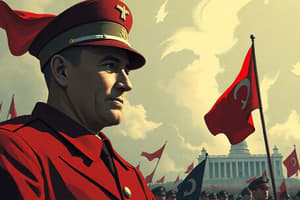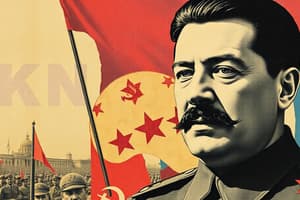Podcast
Questions and Answers
Which characteristic is most indicative of a totalitarian regime?
Which characteristic is most indicative of a totalitarian regime?
- Limited political opposition and controlled elections.
- State control over all aspects of public and private life. (correct)
- Emphasis on military strength and expansionist foreign policy.
- Protection of individual rights and freedoms under a constitution.
How did the Reichstag Fire contribute to the establishment of a dictatorship in Nazi Germany?
How did the Reichstag Fire contribute to the establishment of a dictatorship in Nazi Germany?
- It was used to justify the Emergency Decree, which suspended civil liberties. (correct)
- It led to direct military intervention, overthrowing the Weimar Republic.
- It resulted in the immediate passage of laws that created a socialist economy.
- It triggered an economic boom, which consolidated popular support for the Nazi Party.
Which of the following best describes a 'reactionary' political ideology?
Which of the following best describes a 'reactionary' political ideology?
- Advocating for radical and revolutionary change to the existing order.
- Embracing multiculturalism, diversity, and international cooperation.
- Promoting gradual reform and progress within the existing system.
- Seeking to return to a previous, often idealized, social or political state. (correct)
What was the primary goal of the USSR's Five-Year Plans under Stalin?
What was the primary goal of the USSR's Five-Year Plans under Stalin?
Which of these policies is most closely associated with Lenin's War Communism?
Which of these policies is most closely associated with Lenin's War Communism?
How did the Enabling Act transform German governance?
How did the Enabling Act transform German governance?
What event is most closely associated with the start of organized violence against Jews in Nazi Germany?
What event is most closely associated with the start of organized violence against Jews in Nazi Germany?
Which factor most significantly contributed to the rise of Fascism in Germany after World War I?
Which factor most significantly contributed to the rise of Fascism in Germany after World War I?
What distinguished Lenin's New Economic Policy (NEP) from War Communism?
What distinguished Lenin's New Economic Policy (NEP) from War Communism?
What was the primary intention behind the Nuremberg Race Laws?
What was the primary intention behind the Nuremberg Race Laws?
What was the Holodomor, and what caused it?
What was the Holodomor, and what caused it?
What was the significance of the Dawes Plan in the 1920s?
What was the significance of the Dawes Plan in the 1920s?
How did propaganda contribute to the establishment and maintenance of totalitarian regimes?
How did propaganda contribute to the establishment and maintenance of totalitarian regimes?
Which of the following best describes the concept of a 'cult of personality' as employed in totalitarian states?
Which of the following best describes the concept of a 'cult of personality' as employed in totalitarian states?
How did the Night of the Long Knives (1934) consolidate Hitler's power in Nazi Germany?
How did the Night of the Long Knives (1934) consolidate Hitler's power in Nazi Germany?
What was Hitler's 'Final Solution'?
What was Hitler's 'Final Solution'?
In the context of the Soviet Union, who were the 'kulaks,' and what happened to them?
In the context of the Soviet Union, who were the 'kulaks,' and what happened to them?
What is the crucial difference between totalitarian and authoritarian governments?
What is the crucial difference between totalitarian and authoritarian governments?
What was the Munich Beer Hall Putsch?
What was the Munich Beer Hall Putsch?
Which ideology seeks to eliminate class divisions and establish equality through state ownership?
Which ideology seeks to eliminate class divisions and establish equality through state ownership?
Flashcards
Communism
Communism
A system eliminating class divisions and establishing equality through state ownership.
Fascism
Fascism
A system with extreme nationalism, a strong dictator, and state control of society.
Reactionary System
Reactionary System
Wanting to return to a previous traditional social or political order.
Radical System
Radical System
Signup and view all the flashcards
Propaganda
Propaganda
Signup and view all the flashcards
USSR's 5-Year Plans
USSR's 5-Year Plans
Signup and view all the flashcards
Stalin’s Gulags
Stalin’s Gulags
Signup and view all the flashcards
The Holodomor
The Holodomor
Signup and view all the flashcards
Kulaks
Kulaks
Signup and view all the flashcards
War Communism
War Communism
Signup and view all the flashcards
NEP (New Economic Policy)
NEP (New Economic Policy)
Signup and view all the flashcards
Reichstag Fire Consequence
Reichstag Fire Consequence
Signup and view all the flashcards
Enabling Act
Enabling Act
Signup and view all the flashcards
Nuremberg Race Laws
Nuremberg Race Laws
Signup and view all the flashcards
Kristallnacht
Kristallnacht
Signup and view all the flashcards
Hitler’s Final Solution
Hitler’s Final Solution
Signup and view all the flashcards
Night of the Long Knives
Night of the Long Knives
Signup and view all the flashcards
Rise of Fascism in Germany
Rise of Fascism in Germany
Signup and view all the flashcards
Totalitarian vs. Authoritarian
Totalitarian vs. Authoritarian
Signup and view all the flashcards
The Dawes Plan
The Dawes Plan
Signup and view all the flashcards
Study Notes
- Communism aims to abolish class divisions and achieve equality through state ownership.
- Fascism prioritizes extreme nationalism, a powerful dictator, and state control over society.
- A reactionary system seeks a return to a past, traditional social or political structure.
- A radical system aims for comprehensive change to the existing order, often via revolution.
- Totalitarian dictatorships employ propaganda and fear/terror tactics.
- Propaganda involves biased or misleading information to promote a political viewpoint.
- The USSR’s 5-Year Plans under Stalin aimed for rapid industrialization and economic modernization.
- Stalin’s gulags were severe Soviet labor camps for political prisoners & dissenters.
- The Holodomor was a man-made famine in Ukraine (1932–33) resulting from Stalin’s collectivization.
- Kulaks were wealthier peasants in the USSR, targeted by Stalin during collectivization.
- War Communism was Lenin’s strict economic policy during the Russian Civil War, featuring state control.
- The NEP (New Economic Policy) was Lenin's initiative allowing limited private enterprise to rebuild the economy.
- The Reichstag Fire led to the Emergency Decree, suspending civil liberties in Germany.
- The Enabling Act allowed Hitler to enact laws without the Reichstag, effectively making him dictator.
- The Nuremberg Race Laws were Nazi laws that deprived Jews of German citizenship and rights.
- Kristallnacht involved coordinated attacks on Jewish businesses, homes, and synagogues in 1938.
- Hitler’s Final Solution was the Nazi plan to exterminate Jewish people (The Holocaust).
- The Night of the Long Knives was Hitler's purge of SA leadership and political opponents in 1934.
- The rise of Fascism in Germany was caused by the Treaty of Versailles, economic collapse, hyperinflation and the Great Depression.
- Totalitarian governments control all aspects of life; authoritarian governments mainly control politics.
- The Dawes Plan was a U.S. initiative to loan money to Germany to stabilize its economy in the 1920s.
- The Munich Beer Hall Putsch was Hitler's unsuccessful coup attempt in 1923.
Studying That Suits You
Use AI to generate personalized quizzes and flashcards to suit your learning preferences.




